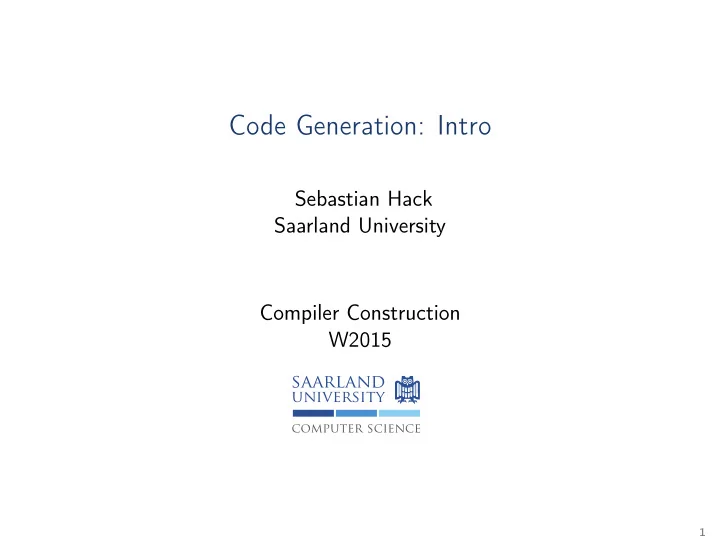

Code Generation: Intro Sebastian Hack Saarland University Compiler Construction W2015 saarland university computer science 1
Code Generation Consists (roughly) of three parts: 1. Instruction Selection Select processor instructions for IR instructions 2. Instruction Scheduling Linearize data-dependence graph of each basic block. 3. Register Allocation For each program point, decide which IR variable resides in what register or in memory. Properties: � All three are influence each other (phase ordering problem) � For reasonably realistic scenarios, each one is a NP-hard optimization problem � Compilers usually attack them heuristically (which works ok, often well) 2
Target Properties that Compilers have to care about � Instruction set architecture (ISA) of the CPU – How to “talk” to the processor – Affects several optimizations and transformations � Aspects of the CPU’s implementation – Organization of instruction execution (pipeline) – Memory hierarchy topology (cache sizes, associativity, sharing among cores) – Core topology (for automatic parallelization) � Conventions of the runtime / operating system – parameter passing of subroutines in libraries – how to address global data – interface to garbage collector – . . . 3
Instruction Set Architectures � RISC – Many registers, typically 32 – Few simple address modes – Load-/store-architecture – three-address code: Rz ← Rx ⊕ Ry – constant-length instruction encoding, typically 4 bytes – VLIW like RISC but compiler packs insns into bundles and manages parallel exec of instructions � CISC – Fewer registers, 8–16 – Complex address modes – Memory operands – two-address code: Rx ← Rx ⊕ Ry – variable-length instruction encoding (x86: from 1 to 15 bytes) Beware of the classical RISC / CISC debate! Today, most CPUs are RISC inside but might have CISC ISA. The processor translates CISC instructions into RISC instructions internally 4
ISA Examples: MIPS � prototypical RISC ISA � 32 registers � minimal core instruction set # $a0 = A, $a1 = i sal $t0 $a1 2 int *A; addu $t0 $a0 $t0 ... lw $t1 8($t0) A[i+2] += 100 addiu $t1 $t1 100 sw $t1 8($t0) = 20 Bytes 5
ISA Examples: x86 � CISC ISA � 8 Registers (64-bit mode 16 registers) � Powerful addressing modes: base register + (1,2,4) * index register + constant � For many instructions, one operand can be a memory cell (instead of reg) � Inhomogeneous register usage: some registers only work with some instructions � Hundreds of instructions in vector extensions # ebx = A, ecx = i int *A; mov eax , 100 ... add [ebx + ecx*4 + 8], eax A[i+2] += 100 = 5 Byte 6
ISA Examples: ARM � RISC-style: load/store, fixed-size insns, three-adress code � CISC-style: addressing modes (barrel shifter, pre/post increment/decrement) � 15 Registers (Reg 15 is PC) � Every instruction can be predicated (effect only on certain condition) Addressing Modes: RSB r9 , r5 , r5 , LSL #3 ; r9 = r5 * 8 - r5 or r9 = r5 * 7 SUB r3 , r9 , r8 , LSR #4 ; r3 = r9 - r8 / 16 ADD r9 , r5 , r5 , LSL #3 ; r9 = r5 + r5 * 8 or r9 = r5 * 9 LDR r2 , [r0 , r1 , LSL #2] ; r2 = M[r0 + 4 * r1] LDR r2 , [r1], #4 ; r2 = M[r1], r1 = r1 + 4 Predication: CMP r3 ,#0 BEQ skip CMP r3 ,#0 ADD r0 ,r1 ,r2 ADDNE r0 ,r1 ,r2 skip: 7
Hardware Properties relevant to the Compiler � In-order execution: – Compiler has to manage instruction level parallelism – Instruction scheduling very important direct influence on code latency – Cores have different functional units / pipes Not every instruction can go into each pipe – VLIW processors allow to pack instructions into bundles � Out-of-order execution: – Processor schedules instructions to functional units dynamically Analyzes data dependences of instruction stream – Resolves false dependencies by register renaming: Internally, processor has way more regs than the ISA has – Instruction scheduling less important because done by CPU – List of instruction merely a “data structure” to communicate the data dependence graph to the processor – Avoiding spill code is more important (critical) 8
Out-of-order vs. In-order � OOO costs more energy � OOO allows for worse compilers � OOO goes well along with speculation � Modern OOO processors speculate over several loop iterations to keep the FUs busy � Hard to imagine that something similar can be done statically � Itanium (high-performance Intel VLIW CPU from the 2000s) is considered a failure � Unclear, if same performance for less energy can be achieved with in-order arch and better compilers 9
Recommend
More recommend